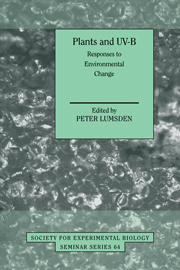Book contents
- Frontmatter
- Contents
- List of contributors
- Preface
- PART I The ozone layer and UV-B radiation
- PART II Effects of UV-B on plants at the cellular level
- DNA damage and repair in plants
- Genetic analysis of DNA repair in plants
- Photosynthesis and photoinhibition
- UV-B effects on the expression of genes encoding proteins involved in photosynthesis
- UV-B perception and signal transduction
- Ultraviolet radiation as a stress factor and the role of protective pigments
- PART III Effects of UV-B at the whole plant and community level
- Index
Ultraviolet radiation as a stress factor and the role of protective pigments
Published online by Cambridge University Press: 04 August 2010
- Frontmatter
- Contents
- List of contributors
- Preface
- PART I The ozone layer and UV-B radiation
- PART II Effects of UV-B on plants at the cellular level
- DNA damage and repair in plants
- Genetic analysis of DNA repair in plants
- Photosynthesis and photoinhibition
- UV-B effects on the expression of genes encoding proteins involved in photosynthesis
- UV-B perception and signal transduction
- Ultraviolet radiation as a stress factor and the role of protective pigments
- PART III Effects of UV-B at the whole plant and community level
- Index
Summary
Introduction
Ozone-depleting substances as well as global climatic changes (for example, increasing ‘greenhouse’ gases) may alter ozone chemistry by creating conditions that facilitate an increased ozone degradation. It is also of concern that ozone reductions are not confined to the Antarctic, but extend to mid-latitudes in both hemispheres (see chapter by Pyle, this volume). A reduced stratospheric ozone layer will result in a selective increase at the earth's surface of ultraviolet radiation in the spectral region 280–320 nm (UV-B). The wavelength specificity is due to the absorption coefficient of ozone, which decreases sharply in the short wave UV-B region. Enhanced levels of UV-B radiation may affect the regulatory mechanisms of many plant processes, causing changes in the internal photosynthetic light micro-environment of the leaf, inducing ultrastructural changes, altering morphology and compounding photoinhibition by visible radiation, to name but a few.
The tolerance and avoidance of UV-B stress is manifested in a range of plant strategies, with increased UV-screening compounds being one of the most widely occurring responses. In addition, plants growing in environments of naturally high UV-B irradiances tend to be more tolerant than plants from low irradiance areas (Robberecht & Caldwell, 1986; Ziska, Teramura & Sullivan, 1992). The importance of the distribution within leaves of UV-absorbing pigments can be shown by comparing internal radiation gradients with the pigment concentrations and absorption curves.
- Type
- Chapter
- Information
- Plants and UV-BResponses to Environmental Change, pp. 157 - 168Publisher: Cambridge University PressPrint publication year: 1997
- 52
- Cited by



